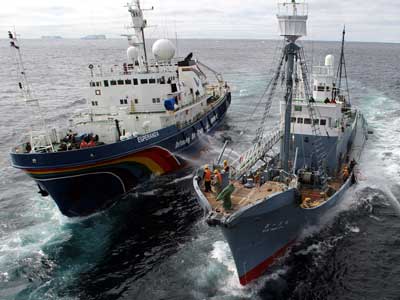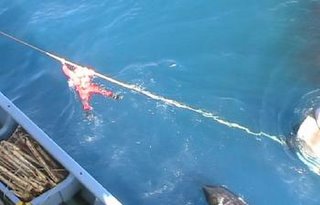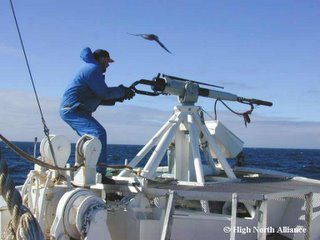Sea Shepherd and Greenpeace Run Out of Fuel Leaving Minke Whales to the Mercy of Japanese Harpooners

After dogging Japanese whalers for more than a month in the waters off of Antarctica, both Sea Shepherd and Greenpeace announced late last week that they were abandoning the fight to save the minke whales and were returning to port in Cape Town. Both groups cited dwindling supplies of fuel and food as the reasons for throwing in the towel.

Relying upon a loophole in international law which allows whales to be slaughtered for so-called "scientific" reasons, Japan plans to kill nine-hundred-thirty-five minkes and one-hundred endangered seis this whaling season; over the next two years it will kill an additional fifty humpbacks, listed by conservationists as vulnerable, and forty endangered fin whales. The Japanese's justification for the hunt is, of course, a barefaced lie. The defenseless whales are being stalked and mercilessly killed for only one reason: money. The meat from the minkes, which the Japanese disparagingly call the "cockroaches of the sea," is sold as steaks and burgers and the whale's sperm is considered a delicacy. The photograph on the right above of a minke being butchered and the one on the left below of another minke stretched out for measuring are proof positive of the Japanese's true intentions.

Since the International Whaling Commission (IWC) banned commercial whaling in 1986, the Japanese have killed at least 7900 minkes, 243 Brydes, 140 sei, and 38 sperm whales. Worst still, the Southern Ocean Whale Sanctuary where the hunt is currently taking place was declared off limits to whalers in 1994. Although seventeen world governments, including those of the United States and England, last week lodged a formal protest with the Japanese government over the illegal hunt, none of them has lifted a finger to stop it.
The hypocritical, phony-baloney United States has even dispatched a naval vessel belonging to its anti-piracy agency to the area in order to keep tabs on the activists and to assist the whalers! The Evil Empire's duplicitous conduct is exceeded only by its greed and lust for blood. Australia and New Zealand have likewise not only turned down demands made by the Green Party in both countries to intervene militarily in order to protect the whales but they have also vociferously attacked both Sea Shepherd and Greenpeace. Captain Paul Watson (See photo at the bottom of the page) of Sea Shepherd, who has labeled the two nations' inaction as "contemptible," told The New Zealand Herald on January 14th, "I think they're kissing the rear ends of Japan." The United Nations has been conspicuously silent on this grave matter despite the fact that its World Charter for Nature empowers individuals and organizations to safeguard and conserve nature in areas beyond national jurisdiction.

With the notable exceptions of the New Zealand and Australian press, London's Independent, and Reuters, the capitalist media have all but ignored the unfolding life and death drama being played out at the bottom of the world. According to Greenpeace, the Japanese have so far killed one-hundred-twenty-three minkes but with the whales' defenders having vacated the playing field that number is certain to grow exponentially up until the time the hunt officially ends in the middle of March.
As far as the combatants are concerned, it is truly remarkable that no lives were lost during the dangerous games that the two sides played. The Japanese, for instance, trained their water cannons on Greenpeace's inflatable boats (See photos above and directly below) and attacked their crews with metal rods and hooks. They also used their larger and faster ships to ram the activists' boats and fired harpoons dangerously close to Greenpeace's inflatable vessels. On January 14th, Greenpeace's Texas Joe Constantine was thrown overboard when a harpoon line became entangled with his craft. (See photo further down the page on the left.) His companions were able to rescue him but had not the minke died fairly soon he could have been dragged under the current.

For their part, Greenpeace attempted to obscure the harpooners' view by erecting walls of water in front of them and by positioning their inflatables between the harpooners and the minkes. They have also used their two main ships, Arctic Sunrise and the Esperanza to block the Japanese chaser ships from transferring their bounty to their factory ships. The photo at the very top of the page shows the Esperanza on the left attempting to prevent one of the Japanese's chaser ships from transferring its kills to a factory ship.
Sea Shepherd, which is headquartered in Washington State, took a considerably more militant approach to dealing with the Japanese. Not only did it ram the whaling vessels, but it also used steel cables to foul their propellers and a steel blade to cut open their hulls. Watson's flagship, the famed Farley Mowat with the Jolly Roger proudly billowing in the breeze, (See photo near the bottom of the page) is also equipped with a so-called goo gun which shoots pie filling and a helicopter which is used to scour the sea for the faster-sailing whaling ships. Watson estimates that Sea Shepherd's aggressive tactics kept the Japanese from recording any kills on at least fifteen separate days.

The transplanted Canadian who annually risks his life battling seal hunters off Canada's eastern coast, defended his actions in an interview with The New Zealand Herald by arguing, "When critics say we are going too far, our answer is that, for the whales, things have already gone too far."
Japan is not the only nation slaughtering whales. Norway will kill 1052 this year and Iceland will bag thirty-nine. Russia also kills an undetermined number of whales each year. Plus, aborigines in Alaska, Canada, Greenland, Russia, and St. Vincent and the Grenadines kill hundreds more each year using old-fashioned harpoons. If all of this were not bad enough, now the Caribbean and African nations want to get in on the killing spree. Although many people believe that their sudden interest in whaling is motivated by foreign aid received from the Chrysanthemum Throne, these nations are nonetheless expected to petition the IWC for permission to join the hunt at its powwow in St. Kitts and Nevis in late May and early June.

Despite the detrimental effect that hunting has on the more than eighty species of whales that are known to exist, it is merely one of several factors conspiring against these magnificent creatures. Commercial fishing has not only diminished the supply of fish and sand eels which whales feed upon but they often become entangled in huge fishing nets and other gear and thus die painfully slow deaths. Pollution is another concern and belugas in the St. Lawrence River have been found to contain high-levels of PCBs. Climate change is also putting southern right whales at risk of skin cancer because of the depletion of the ozone layer. A new high-powered sonar system recently developed by the Evil Empire's navy has been blamed for the stranding deaths of thousands of whales off the coasts of New Zealand, Australia, Washington State, the East Coast of America, and elsewhere.

In an article entitled "Whales: In Deep Trouble," published in the January 9th edition of The Independent, Philip Hoare took great pains to point out the hypocrisy inherent in the Americans' and the English's opposition to the Japanese's whaling activities. He correctly noted that up until the discovery of petrol in 1859 that the great cities of Europe and America were lighted with oil derived from sperm whales and that baleen was used to manufacture corsets and umbrellas. He further pointed out that before 1960 whales were used in the making of margarine, ice cream, cosmetics, and pet food. Even whale puke is valuable. Only recently a couple of beachcombers in Australia found 14.75 kilograms of ambergris, a wax-like substance belched up by sperm whales, worth around $1 million. The foul-smelling excreta is used as a fixative in perfumes, for medicinal purposes, and as an aphrodisiac. (See "Whale Vomit Worth Millions," The Australian, January 25, 2006.) Nonetheless, two wrongs do not make a right and the past crimes of the English and the Americans cannot be used as a justification for Japan and other nations, aborigines included, to continue their whaling operations.
Killing a whale has always been a cruel and agonizingly slow process. For instance, two-hundred-year-old Inupiat harpoons have been found embedded in the backs of bowhead whales. Today, the Japanese, Norwegians, and other commercial whalers use grenade-tipped harpoons (See photo above of a Norwegian harpooner) which are designed to kill instantaneously. That is seldom the case, however, and often the whales take ten or more minutes to die. If the explosions do not kill them, they often succumb to asphyxiation while their heads and blowholes are being held below the surface by harpoon lines. (See photo above on the right of a bloody minke which has just been harpooned.) Should they somehow survive all of that, the whalers finish them off with rifle shots to the head. Clearly, this barbarism must be stopped.

In so much that it has not stopped the slaughter of these magnificent creatures of the deep, the IWC is a miserable failure. Worst still, the political will does not exist outside the commission to stop the killings. The whales' only real hope at the moment lies with courageous defenders like Sea Shepherd and Greenpeace. As Paul Watson said in 2002, "We should never feel like we're going too far in breaking the law, because whatever laws you break to liberate animals or to protect the environment are very insignificant."
As for Greenpeace, it may have given up the battle in the Southern Ocean Whale Sanctuary but it certainly has not eased up one bit in its publicity campaign against Japan. On January 19th, it took a fin whale which had died in the Baltic Sea town of Warnemunde and dumped it in front of the Japanese Embassy in Berlin. (See photo directly above.)

Watson, however, does not believe that publicizing the barbarous nature of whaling will ever lead to its eradication. On his web site he states: "Incredible amounts of money are spent on public relations, advertising, and documentation of the killing. The images are captured and distributed. We see the whales dying in horrific agony, and the killing continues and continues despite the protests."

Captain Watson is, of course, correct. A good public relations campaign is useless unless it is linked to a well-financed armed resistance. As Machiavelli said a long time ago, armed princes succeed where unarmed ones come to ruin. Therefore, if he can raise the money, Watson plans to return to the waters off of Antarctica this coming December with a faster, longer-range ship and to chase the Japanese out. For their part, the Nipponese have threatened in the past to call in their air force in order to protect their whaling fleet. Things could get bloody but for the minkes things are already bloody and deadly.
Photos: Greenpeace (Esperanza, butchered minkes, water cannons, whalers' attack, and harpooned minke), Institute of Cetacean Research (minke being measured and Texas Joe Constantine), High North Alliance (harpooner), DPP via Der Spiegel (Berlin whale), and Sea Shepherd (Farley Mowat and Paul Watson).

<< Home